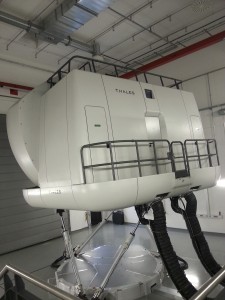2015-02-12 The A400M is being operated already by 4 air forces, with 4 more initial customers to come.
It is early days but the interactive process of multi-national training will be a crucial aspect of shaping an A400M enterprise.
A briefing provided in 2012 by the head of training for the 400M anticipated the process.
One of the more interesting presentations at the Airbus Military Trade Media Brief 2012 was by the head of training at Airbus Military.
Ian Burrett, Head of Training and Aircrew Operations, Customer Services, provided an overview of the approach and the standing up of the baseline training capability.
The multi-national training center opened up at Seville in late 2010 and Airbus Military will roll out capabilities through 2013 to make the training facility completely operational.
The A400M program like the F-35 program is built for multi-national training.
In the A400M case, there is a core or central training facility at Seville, which develops the core competencies and approaches and defines best practices.
The Seville center – like Eglin in the F-35 system – can operate as a hub for national training facilities, and national facilities can then replicate, link or incorporate via virtual links, systems and approaches with the capabilities of the multi-national training center.
The basic A400M includes three core personnel – a pilot, a co-pilot and a loadmaster.
The training is built to train a core team. The loading system of the A400M is highly automated, and can be operated by a single person. As an advanced system, it is important that the training be especially effective with the loadmasters…..
Although not discussed, not perhaps planned at this time, the A400M like the F-35, can shape a new learning approach to training upon which the program can evolve over time.
Over time, as the plane becomes operational, and the fleet gains experience operated by several national militaries, there will then be the opportunity to feed that experience into the training program.
There is the possibility of shaping a con-ops training or sharing capability built on the multi-national character of the program.

And the first Air Force deploying the A400M, the French Air Force (FAF), is leveraging the multi-national aspects of training and looking forward to operational convergence of the plane as well.
The French head of the Multinational Entry To Service Team in the FAF highlighted the importance of the multi-national aspects.
The MEST worked closely with the British as well as the Germans in preparing the ground for the future. Lt. Col. Creuset noted that the FAF has an agreement with the Royal Air Force’s Air Warfare Center and this relationship has been tapped into to shape a way ahead.
“We can profit from their experience and they can profit from ours.”
This theme is clearly a key part of the entire approach to standing up and looking forward to the operational use by a multinational fleet, from the French perspective.
Now the Germans are standing up their capabilities to do A400M training in Germany.
According to a press release dated February 9, 2015 by Airbus Defence and Military:
The German Air Force (GAF) has taken delivery of a Full Flight Simulator (FFS) for the A400M aircraft provided by Airbus Defence and Space.
The training device entered service at Wunstorf Air Base, where the GAF A400M fleet will be based, on 8 January and will be used to train about 60 GAF crews in its first three years in operation.
Developed by Airbus Defence and Space and manufactured by Thales, it is a full replica of the A400M cockpit.
As provider of a wide scope of training products and services to air forces, Airbus Defence and Space will deliver to the GAF additional training devices consisting of:
- a Flat Panel – Flat Training Device (FP–FTD), which is a cockpit partial simulator to train pilots prior to the FFS training;
- a Cargo Hold Trainer (CHT), which is a full 1:1 scale replica of the A400M cargo hold used to train loadmasters with real loading and unloading tasks as well as to train parachutists;
- and a Cockpit Maintenance Operations Simulator (CMOS) which replicates the aircraft in 3D images and provides maintenance procedure simulations.
These training devices are due for delivery by mid-2015.
Ian Burrett, HO Training & Aircrew Operations, Military Aircraft, said:
“The delivery of this FFS is an important step in creating the GAF´s own A400M training program and as part of the overall support infrastructure that will sustain the A400M in service for many years to come”.
The GAF took delivery of its first A400M on 18th December 2014.
A presentation on the A400M training program presented at the Airbus Defence and Space Trade Media Brief in 2014 can be seen below:

